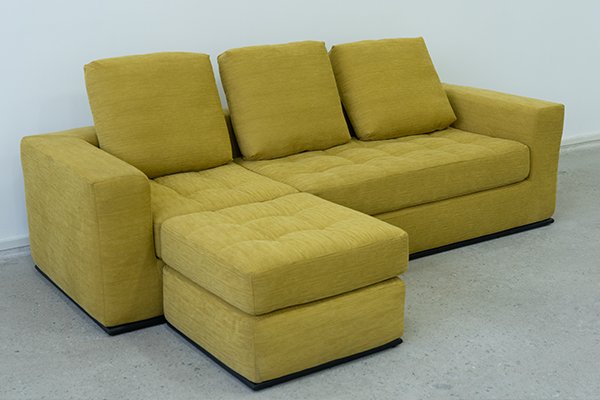
Compressed sofas are revolutionizing modern furniture with their compact packaging, ease of transport, and remarkable durability. But what makes this innovation possible? The answer lies in the high-quality materials used to craft these space-saving solutions. In this article, we’ll explore the materials that form the backbone of compressed sofas and explain how they contribute to the comfort, functionality, and longevity of these unique products.
Compressed sofas are primarily constructed from high-density foams, memory foam layers, durable fabrics, and flexible frames, combining to create a perfect balance of comfort, resilience, and practicality.
1. High-Density Foam: The Foundation of Support
At the core of every compressed sofa is high-density foam, which plays a pivotal role in maintaining the sofa's structure and providing firm support.
Key Features:
- Density Defined: High-density foam, such as the 50D foam used in many premium compressed sofas, weighs 50 kilograms per cubic meter. This density ensures exceptional durability and resistance to wear and tear.
- Support and Longevity: High-density foam maintains its shape after repeated compression and decompression cycles, ensuring the sofa stays firm and supportive over time.
- Load-Bearing Capacity: The foam's tightly packed cell structure provides superior weight distribution, making it ideal for long-term use.
At HSM, we use 50D high-density foam in our compressed sofas to ensure maximum durability and support, even after years of use.
2. Memory Foam: Comfort and Adaptability
Memory foam adds a luxurious touch to compressed sofas, enhancing the comfort and flexibility of the design.
Why Memory Foam Matters:
- Shape Retention: Memory foam is engineered to adapt to the contours of the body, offering personalized comfort with every use.
- Quick Recovery: Its open-cell structure allows it to compress easily during shipping and expand rapidly upon unpacking.
- Soft Yet Supportive: Memory foam provides a cushioning effect without sacrificing support, ensuring a cozy seating experience.
HSM’s sofas feature eco-friendly memory foam that balances comfort and sustainability, catering to environmentally conscious consumers.
3. Durable Upholstery Fabrics
The outer fabric of a compressed sofa not only contributes to its aesthetic appeal but also enhances its durability and usability.
Popular Fabric Options:
- Chenille: Known for its soft texture and durability, chenille is resistant to wear and adds a luxurious feel.
- Corduroy: A stylish and sturdy choice, corduroy provides a vintage charm and is easy to maintain.
- Teddy Fleece: This cozy fabric is perfect for creating a warm, inviting ambiance while being soft to the touch.
In addition to these options, HSM offers customized fabric solutions, allowing customers to select materials that align with their personal style and functional needs.
4. Flexible Frames: Structural Integrity
Although many compressed sofas are frameless, some modular designs incorporate flexible frames to enhance stability and functionality.
Frame Characteristics:
- Detachable Components: Frames in modular compressed sofas can be folded or detached for easier storage and assembly.
- Lightweight and Resilient: These frames are typically crafted from high-quality steel or reinforced plastic to provide robust support without adding excessive weight.
- Durability: Flexible frames are engineered to withstand multiple assembly and disassembly cycles without compromising structural integrity.
For modular sofas, HSM uses advanced lightweight materials to balance portability and strength, ensuring ease of handling and long-lasting use.
5. Eco-Friendly Components
Sustainability is a growing concern for consumers, and many compressed sofas incorporate eco-friendly materials to meet this demand.
Key Eco-Friendly Features:
- Recyclable Foam: High-density and memory foams used in compressed sofas are often made from recyclable materials, reducing environmental impact.
- Low-Emission Fabrics: Sustainable upholstery fabrics minimize the carbon footprint during production.
- Reduced Packaging: The compact design of compressed sofas allows for smaller packaging, which reduces waste and transportation emissions.
At HSM, we prioritize sustainability by sourcing eco-friendly materials and adopting environmentally responsible manufacturing practices.
6. Protective Coatings and Enhancements
To prolong the lifespan of compressed sofas, manufacturers often add protective layers or coatings.
Common Enhancements:
- Stain-Resistant Treatments: Fabrics are treated to repel liquids and resist stains, making cleaning easier.
- UV Protection: Some fabrics come with UV-resistant coatings to prevent fading and deterioration from sunlight exposure.
- Slipcovers: Detachable slipcovers provide an extra layer of protection and are machine-washable for convenience.
HSM offers optional slipcovers and fabric treatments to meet the specific needs of customers, ensuring their sofas remain pristine for years.
Why Material Quality Matters
The quality of materials used in compressed sofas directly impacts their performance, comfort, and durability. High-quality materials:
- Ensure the sofa retains its shape and support after repeated use.
- Enhance the aesthetic appeal and compatibility with modern home designs.
- Prolong the lifespan of the product, offering long-term value for consumers.
Conclusion: Premium Materials for Superior Performance
Compressed sofas owe their innovation and functionality to the advanced materials used in their construction. From high-density foams to durable fabrics and sustainable components, every element works together to deliver a product that is stylish, comfortable, and practical.
At HSM, we take pride in our use of premium materials to craft compressed sofas that meet the highest standards of quality and sustainability. Whether you’re furnishing a small apartment or upgrading your living room, our sofas provide the perfect combination of durability, comfort, and style.
Explore HSM’s Compressed Sofa Collection Today!